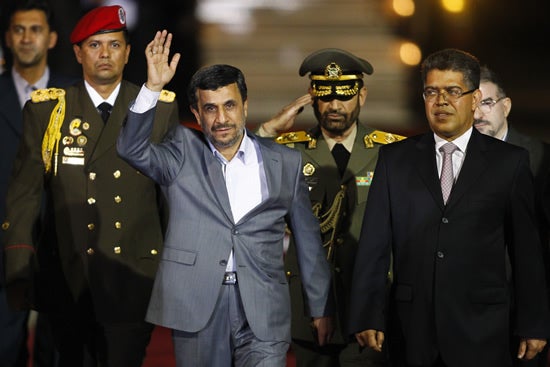Challenges to U.S. international broadcasting and public diplomacy continue to mount. Iran, joining China and Russia, also nourishes ambitions as a global power and is moving forward with soft-power advances in Latin America. (Not that there is anything “soft” about Iranian soft power.)
Part of the explanation is that Iran is desperate to boost its image and economy as it faces broader sanctions and a potential European oil embargo. Iran may also be focusing its propaganda efforts on Latin America to build influence with the Lebanese Shia diaspora there, where its ally Hezbollah has established roots.
Most recently, hoping to “limit the supremacy of dominance seekers” (i.e., the United States), Iran has launched Spanish-language satellite TV, which will broadcast Iranian news, documentaries, and movies 24 hours a day. Though news of Iran may not rivet every Latin American viewer, many of the shows capitalize on anti-American sentiment and are critical of the U.S., including a story claiming that most Americans did not favor sanctions against Iran, a piece criticizing U.S. “plots” against Syria and Venezuela, and a speech by Iranian President Mahmoud Ahmadinejad describing the U.S. as a “selfish and bullying minority.”
Exactly how much Tehran spends on international broadcasting is difficult to quantify, but it is a considerable sum. The Islamic Republic of Iran Broadcasting (IRIB) is a giant enterprise whose reach is matched by high production quality. IRIB broadcasts on 13 different international channels to 45 countries (including the U.S.) in 28 languages.
Iranian media advances in Latin America come at a time when deep budget cuts in American international broadcasting. Voice of America’s Latin Service—as well as the U.S.-government-funded but independent Radio Marti—are facing deep cuts. What a message we are sending to U.S. neighbors to the south.
Beyond broadcasting, Iranians have stepped up their public diplomacy efforts in Latin America.
On his tour of Latin America in January, Ahmadinejad promoted various investment and aid projects, despite the fact that Iran has yet to deliver on any of their previously promised aid. In January the Iranian currency fell as low as 17,800 rials to the U.S. dollar. Ties with Venezuela allow Iran to avoid banking sanctions and create shipping routes out of the country. Iran has been helping Venezuela locate their uranium deposits and allegedly holds partial ownership in a number of Venezuelan uranium mines. Venezuela has created a no-fly zone over one of their “aluminum” mines, which is most likely a front for a joint uranium mine. Many of their manufacturing facilities are similarly suspect.
At a recent Senate committee hearing, panelists showed concern over growing ties between Ahmadinejad and Venezuelan President Hugo Chavez; the shadowy shuttle operation among Tehran, Damascus, Caracas, and Bolivia; and Iran’s manufacturing projects in Latin America. Many lawmakers think that these Latin American countries are “playing with fire.”
Playing with fire is a good way to look at any agreement with the Iranian government. Meanwhile, though, the U.S. government, too, is playing with fire if it abandons the battlefield for influence in this key part of our own hemisphere.
